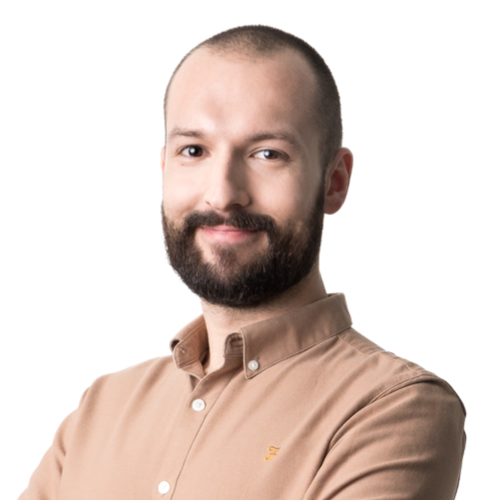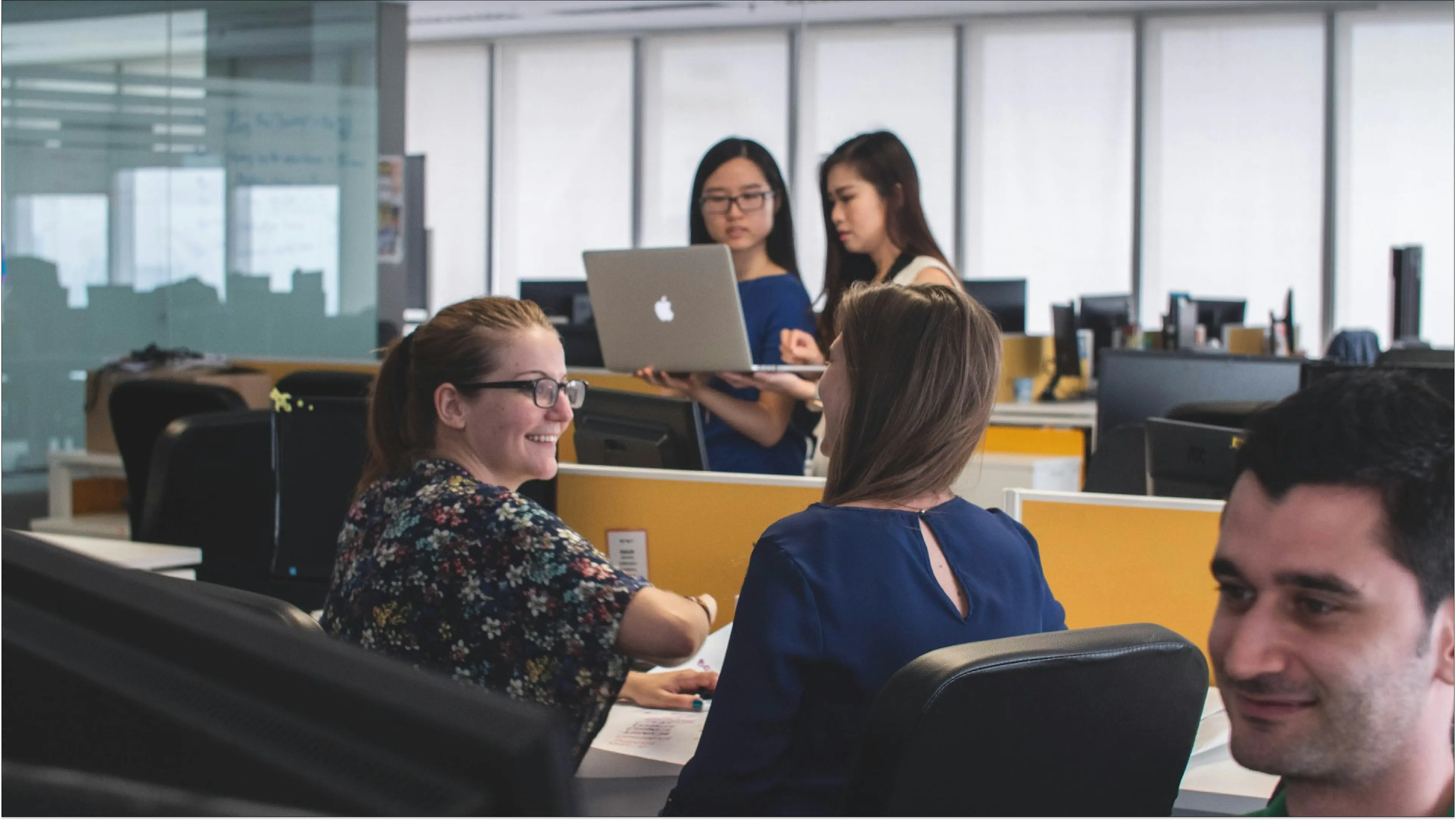7 July 2019 (updated: 24 June 2020)
Workshops Are Rocket Fuel for Product Development
Chapters
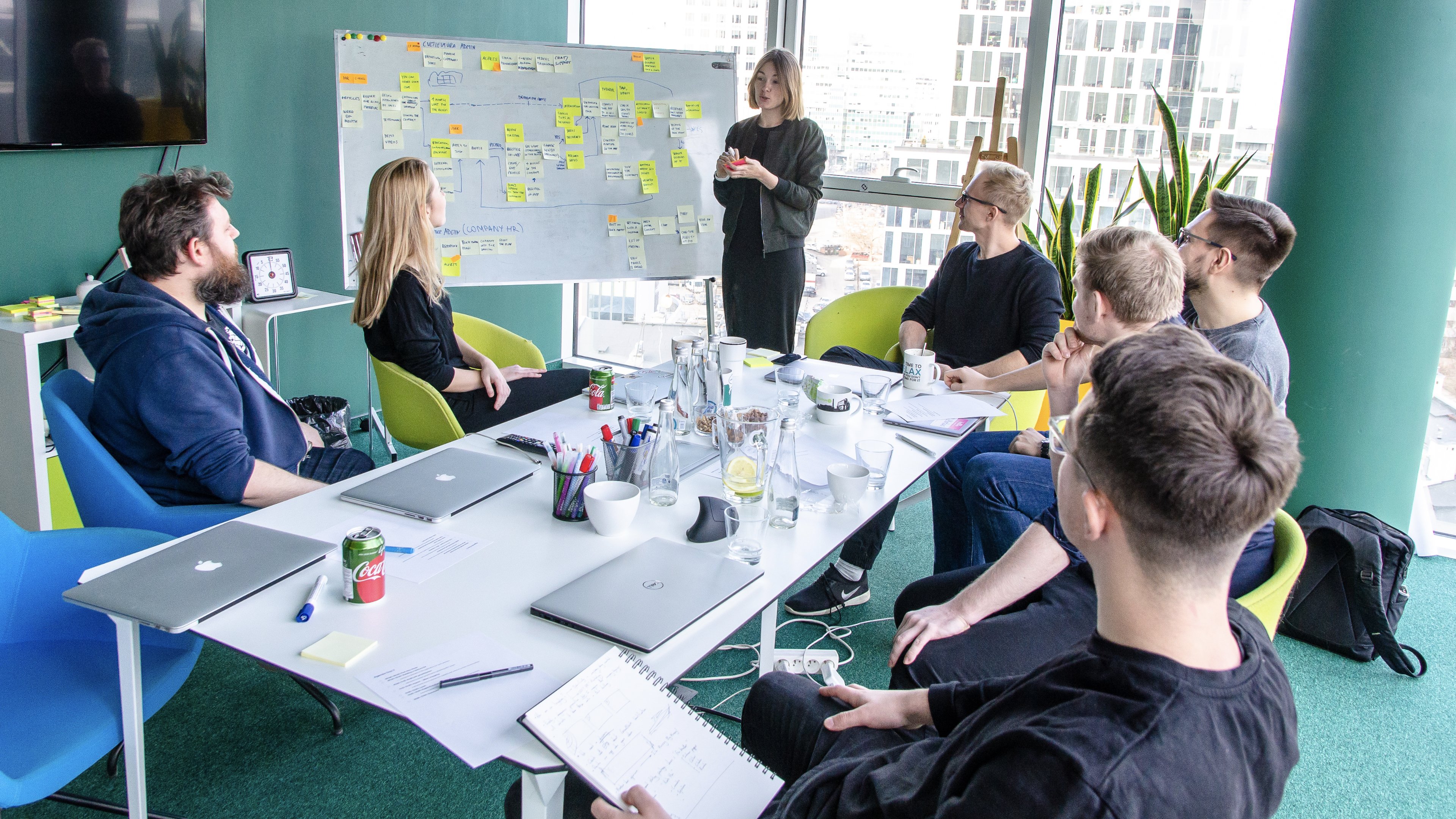
Leverage the power of collaboration to make strategy and design more efficient.
Many professionals are scared of meetings and I can fully understand that. Many meetings in corporate environments are run without a proper agenda and end up without any concrete outcomes. Essentially, a waste of time.
Workshops, on the other hand, are structured meetings that serve a very specific function and, if done properly, can be an extremely efficient weapon in product development. Whether it’s physical products, digital products or services — a whiteboard, a couple of post-its and a well planned session can do wonders in making collaboration a bit closer and outcomes richer.
The silo problem
As companies grow, it’s more difficult to stay aligned and know what’s happening in every department. Quite often, corporate or even startup products are delivered in this unhealthy siloed setup — “the developers sit here, the designers sit there, the marketing is somewhere else and the CEO and CFO are locked out in the corner room”.
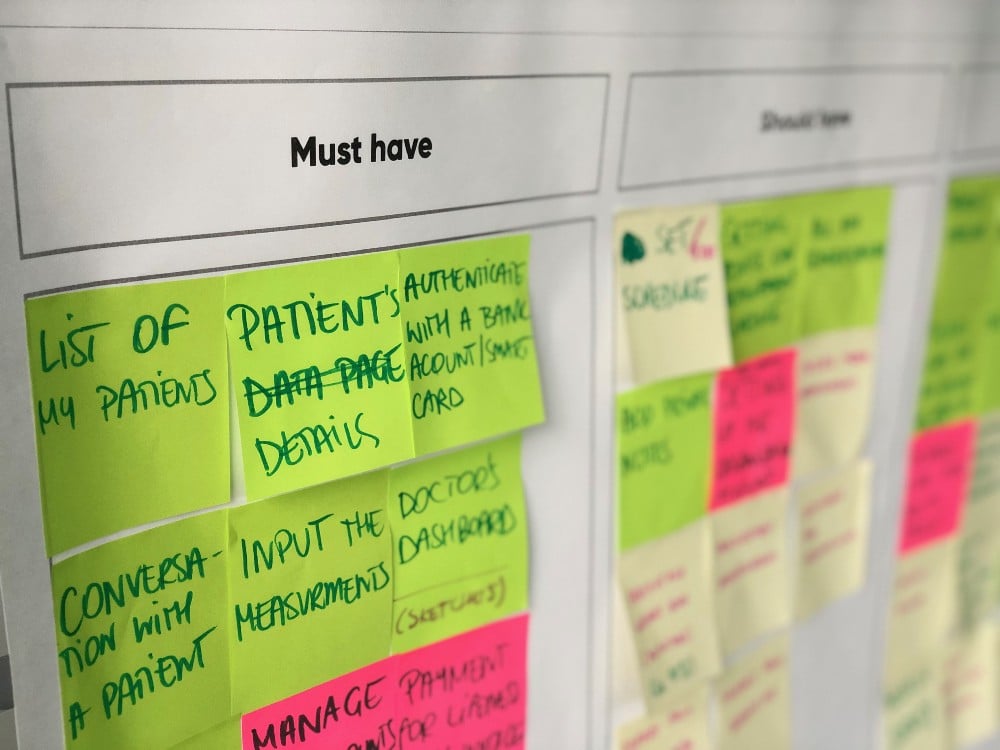 Quite often different departments in the same organisation have different priorities and objectives.
Quite often different departments in the same organisation have different priorities and objectives.
Then, suddenly there is a need for work which involves a number of these functions — a new product or a service. If you get all of those in-house specialists to work together, you usually end up with random brainstorms or pointless meetings about meetings. Then, everybody goes their separate ways and work siloed for weeks.
The truth is, well-designed products emerge where silos are broken down and a cross-functional (and cross-cultural) team works collaboratively for a specific purpose. Despite the recent popularity of Design Thinking, it’s often used as nothing more but a buzzword that looks good on the company website.
Clients should not be treated as brief-pushers
I have done my fair share of projects for clients from all sorts of industries, operating on markets all around the world. And I have never seen a briefing document that would answer all possible questions upfront. There is always a need for countless calls and emails.
Whether you’re working on an internal project, or designing a project for an external client, you will be amazed at what sort of insights emerge from a solid, well-designed workshopping session. If there is one thing my clients say to me after a workshop (besides “that was awesome” 😅) it is this:
Wow, we never get to look at our business from the bird’s-eye view. We just do our day-to-day work and never look at the big picture.
That is true for so many teams — even though sales, customer support or executives have good knowledge of their own backyard, they are often so caught up in weekly routines that they hardly ever get the chance to sit down and look at the bigger picture. In product or service development this problem can be solved with workshopping.
An external perspective
To complement the internal alignment, working with an external consulting or software company such as EL Passion can give you another perspective — from an outsider looking in. This will have some unique benefits, such as:
- Lack of organisational biases
- Detachment from internal politics
- Solid, challenging questions from a beginner’s mind
- More ease in outside-the-box thinking (not being in the box in the first place makes it easier to get outside of it)
In any case of working in a team— there is no better way of aligning the knowledge than meeting face-to-face and workshopping together.
A well-designed workshop can save weeks of work
Of course, every good workshop (or even any meeting) should be properly designed in order to yield the best results. It’s not just about the right room and post-it notes. The right mix of preparation, agenda flow, team setup and facilitation can actually save time further on in the project. Certain questions, answers and decisions made during the session will allow the team to skip some of these tasks and inefficiencies later on. Nobody wants to wait 3 days for an email reply — and in the workshop room, you get what you need in an instant.
The key elements of a successful workshop are:
The prep
The more input content there is for a workshop, the better. Think about interviews, user research and some desk research around the subject matter or the industry of the project (if you have some knowledge gaps). During any workshop it is good to have a basic understanding of the business domain before diving into any activities.
A big part of the preparations is also making sure that the right room is chosen for the right set of methods — at the end of the day, you will need a loooot of wall space.
The agenda
Designing the right, logical flow for the session is key to meet the objectives. The right mix of grounding methods, flow & solution methods and prioritisation will provide you with a framework to guide the discussion. Without a flow like this, the discussion will divert into too many directions — quite often not the ones you had planned to explore.
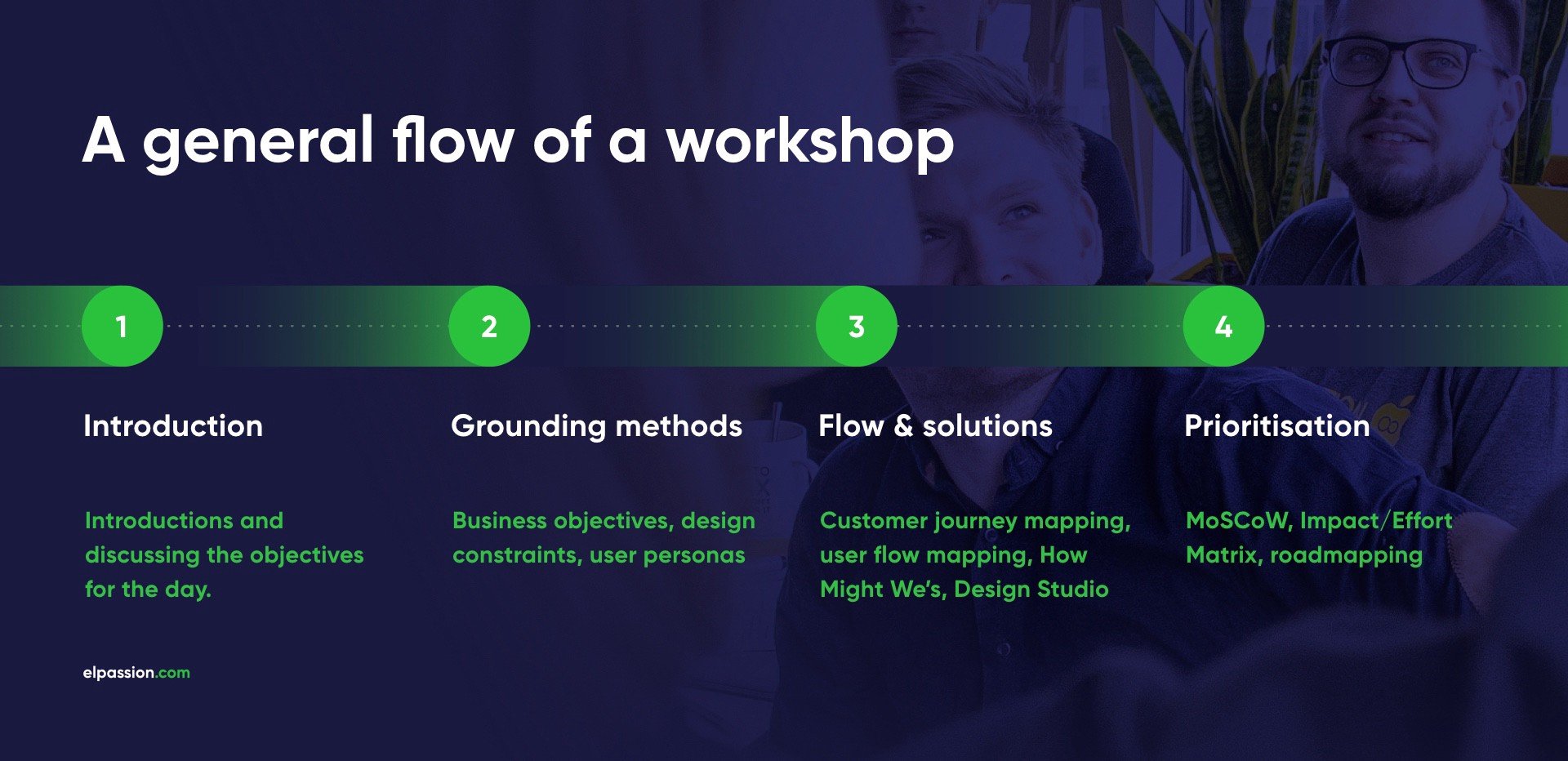 In general, I divide my favourite workshop methods into 4 groups: 1. Introduction, 2. Grounding (business objectives, design constraints, user personas), 3. Flow & solutions (customer journey mapping, user flow mapping, how might we’s, design studio), 4. Prioritisation (MoSCoW, impact/effort matrix, roadmapping).
In general, I divide my favourite workshop methods into 4 groups: 1. Introduction, 2. Grounding (business objectives, design constraints, user personas), 3. Flow & solutions (customer journey mapping, user flow mapping, how might we’s, design studio), 4. Prioritisation (MoSCoW, impact/effort matrix, roadmapping).
Workshop team setup
Choosing the right mix of stakeholders of various cultural and professional backgrounds is particularly important. You should invite people who:
- Are decision-makers in the project,
- Have specialised knowledge about the industry or/and the user base (e.g. customer support staff),
- If possible, are the actual users you are designing the product for.
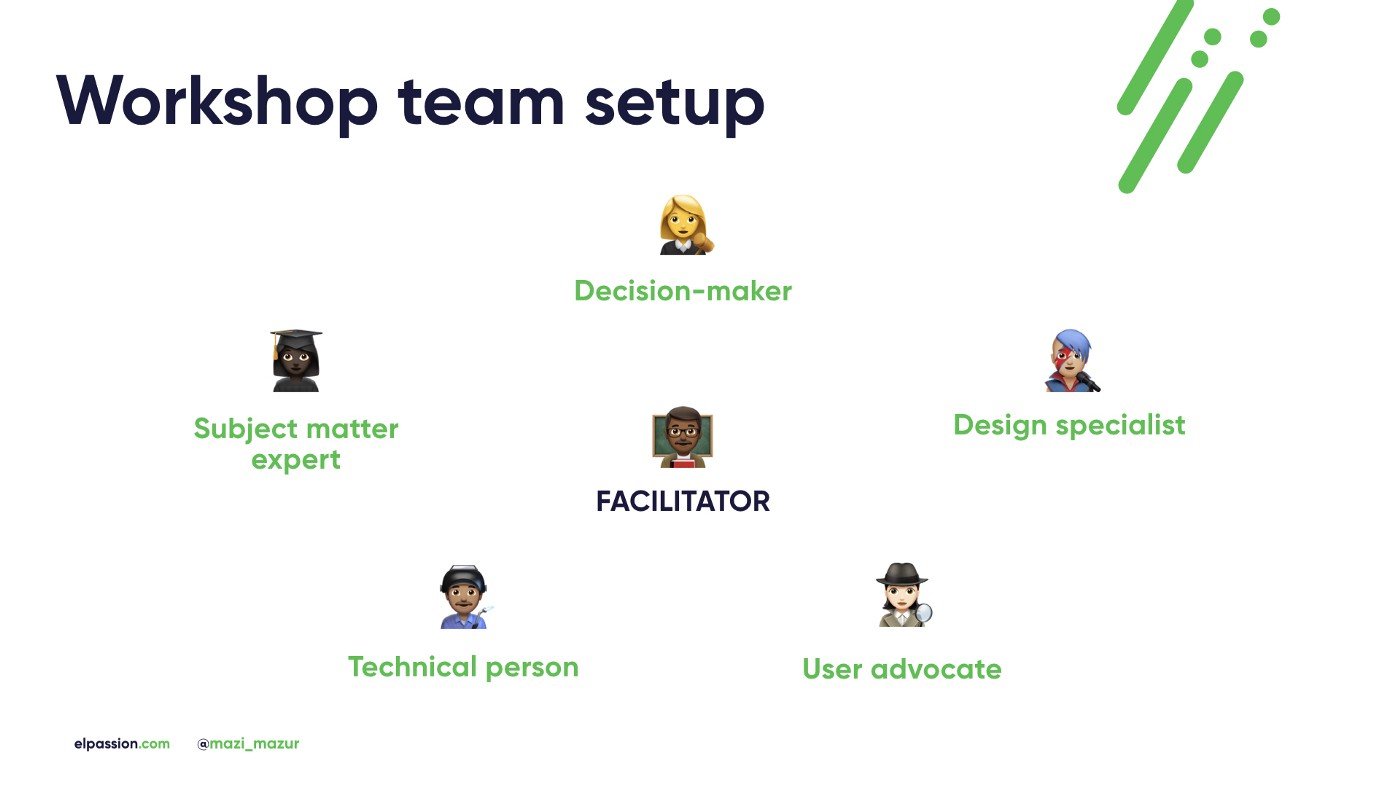
A good workshop team set up would involve: a subject matter expert, a decision-maker, a design specialist, a user advocate, a technical person and a facilitator.
Facilitation
Amazing coffee beans can be wasted if you brew them incorrectly — the whole thing will end up terribly bitter or tasteless. It’s exactly the same with workshops! Even the best preparation and a perfect agenda could be rendered useless if the workshop itself is not properly conducted.
A good facilitator will be able to distribute voice among all participants, motivate to speak up, lead the way through each consecutive method and limit digressions. Facilitation is also about gauging the energy in the room and reacting to it — choosing the right time for breaks, or increasing the intensity of the activities.
Choose your weapon
There is a multitude of workshopping methods and it would be Sisyphean labour to explain them in a single article. That’s why I chose two workshopping methods that, in my opinion, bring the most value to product development. They are easily understood and very engaging for participants, so you won’t need to worry about productivity.
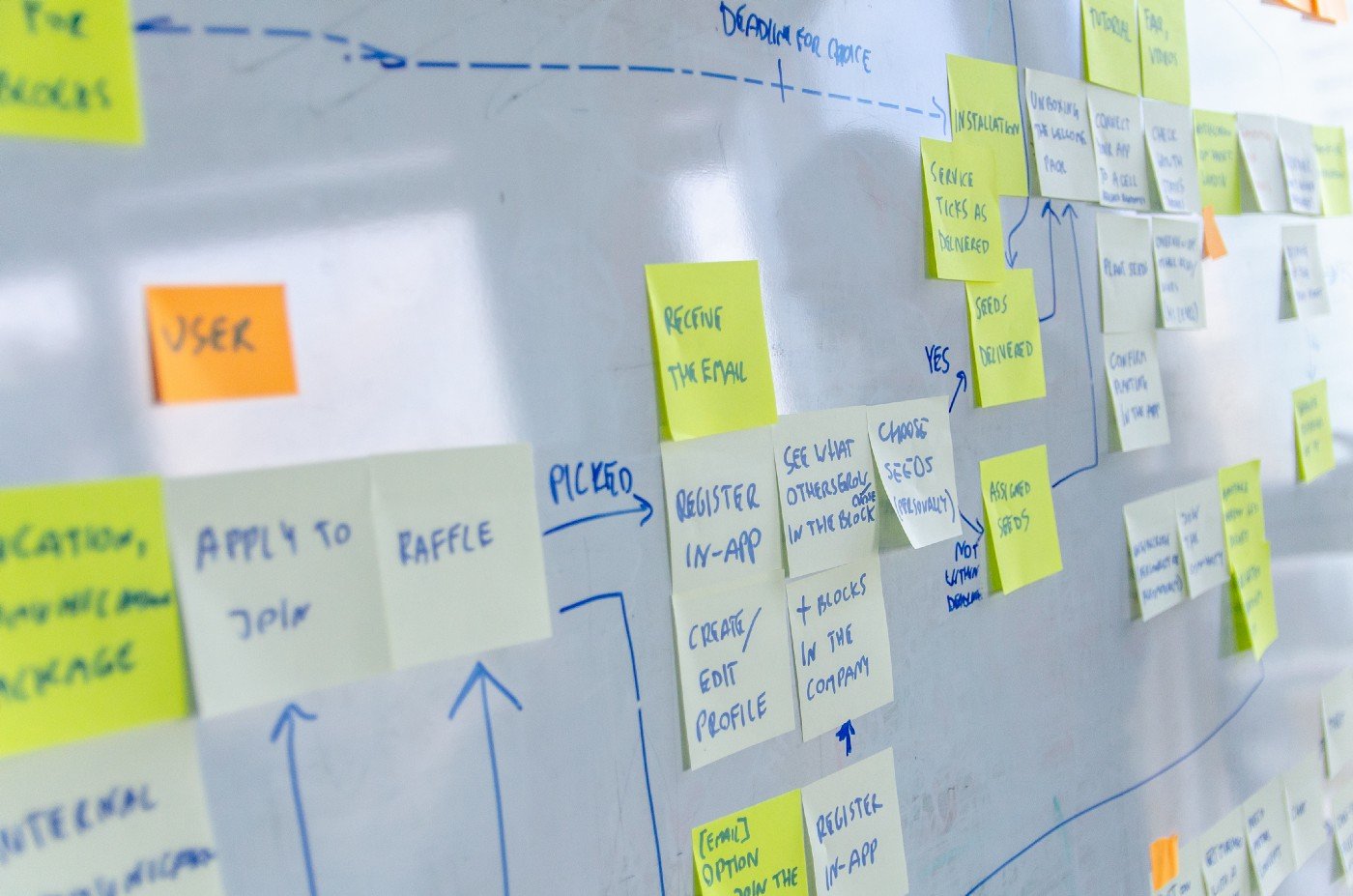 Customer Journey Mapping is useful in getting teams to look at the big picture of the user’s experience.
Customer Journey Mapping is useful in getting teams to look at the big picture of the user’s experience.
Customer Journey Mapping
Customer Journey Mapping is especially useful for complex projects, in which the user’s journey spans beyond the borders of the digital. It’s basically a technique in which you map the user’s steps from the beginning until the very end of their experience. We always do it on a wall or a whiteboard, using sticky notes.
It often contains users’ actions, product touchpoints, pain points or user thoughts/emotions. There are some small things that can assist you in this activity, such as naming the stages of the journey (for better communication), using different colours of sticky notes (for better visualisation) or including decision trees (to reflect the experience better).
Check out this guide from Paul Boag if you want to learn more about this method.
Design Studio
Another great method to explore is Design Studio — a rapid prototyping method based upon short iterations of sketching, pitching and design critique.
It is truly remarkable to spend a full day talking about abstract notions such as business goals, user needs or customer journeys, and then start generating sketches of actual screens. Suddenly all those ideas are coming to life and you get a unique chance to rapidly discuss your solutions and get challenged.
You can read more on this method in my previous article, “A day of 500 sketches.”
Are Workshops worth all of it?
Workshops are expensive, so we should not fool ourselves that they will solve all of the challenges we face in product development. We should treat them as fuel for creativity, inclusivity and team-building in a very focused manner. Teams can reach new heights in cross-team alignment and end up exploring ideas that no one of the team members would come up with alone. Therefore, even if one workshop equals to 32 man-hours in a single day, it’s time well spent, which will be a good seed investment for the rest of the project.
There is tremendous power trapped in teamwork, and workshopping is an amazing tool to release it.

